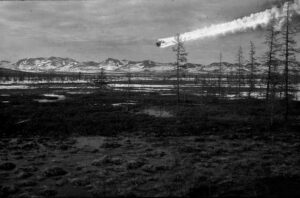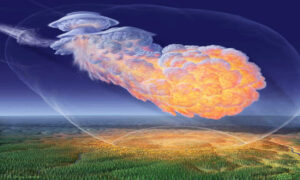 Most of us don’t really think much about the possibility of a meteor hitting the Earth, and the reality is that it’s pretty rare…at least one of much size. Most of them burn up as they enter our atmosphere, and most often the ones that do hit are so small that they do little damage. The Tunguska event a definite exception to that rule. Coming in from the east-southeast, and at and incredible speed of about 60,000 miles per hour, but amazingly still not actually impacting the Earth, it was still classified as an impact event, even though no impact crater has been found. Instead, the object is thought to have disintegrated at an altitude of 3 to 6 miles above the surface, rather than actually impacting the Earth. The meteor did not simply fall apart or burn up, but rather it blew up in what was estimated as a 12-megaton explosion, near the Podkamennaya Tunguska River in Yeniseysk Governorate, which is now Krasnoyarsk Krai, Russia, on the morning of June 30, 1908.
Most of us don’t really think much about the possibility of a meteor hitting the Earth, and the reality is that it’s pretty rare…at least one of much size. Most of them burn up as they enter our atmosphere, and most often the ones that do hit are so small that they do little damage. The Tunguska event a definite exception to that rule. Coming in from the east-southeast, and at and incredible speed of about 60,000 miles per hour, but amazingly still not actually impacting the Earth, it was still classified as an impact event, even though no impact crater has been found. Instead, the object is thought to have disintegrated at an altitude of 3 to 6 miles above the surface, rather than actually impacting the Earth. The meteor did not simply fall apart or burn up, but rather it blew up in what was estimated as a 12-megaton explosion, near the Podkamennaya Tunguska River in Yeniseysk Governorate, which is now Krasnoyarsk Krai, Russia, on the morning of June 30, 1908.
The explosion was over the sparsely populated Eastern Siberian Taiga, which likely saved many lives, but  flattened an estimated 80 million trees over an area of 830 square miles of forest. The people who did witness the explosion, from a great distance, of course, reported that at least three people may have died in the event. The explosion is generally attributed to a meteor air burst, which is the atmospheric explosion of a stony asteroid approximately 160–200 feet in size. The Tunguska event remains the largest impact event on Earth in recorded history, though it is assumed that much larger impacts have occurred in times before history was recorded. An 12-megaton explosion could destroy a large city. Of course, events like this and even smaller ones have caused scientists to attempt to figure out ways to avoid these “direct hits” in the future…a rather large job, since moving the Earth out of the way of asteroids is really not an option.
flattened an estimated 80 million trees over an area of 830 square miles of forest. The people who did witness the explosion, from a great distance, of course, reported that at least three people may have died in the event. The explosion is generally attributed to a meteor air burst, which is the atmospheric explosion of a stony asteroid approximately 160–200 feet in size. The Tunguska event remains the largest impact event on Earth in recorded history, though it is assumed that much larger impacts have occurred in times before history was recorded. An 12-megaton explosion could destroy a large city. Of course, events like this and even smaller ones have caused scientists to attempt to figure out ways to avoid these “direct hits” in the future…a rather large job, since moving the Earth out of the way of asteroids is really not an option.
The Tunguska Event was a mystery for some time, after locals reported hearing a shattering explosion. Upon  investigation, it was found that trees were charred and leveled, and also that seismic waves were felt traveling through Europe. There are still some questions concerning the event, but it is widely believed to have been a comet colliding with Earth’s atmosphere. It is estimated that the explosion occurred 15,000-30,000 feet above the surface of the Earth. That explains the fact that no impact crater was found, still one would expect an explosion of that magnitude to trigger a massive fire. It did not, causing scientists to speculate that the subsequent blast wave doused the flames. Still, the massive amount of energy expelled by the blast is estimated to have been stronger than the bomb dropped on Hiroshima.
investigation, it was found that trees were charred and leveled, and also that seismic waves were felt traveling through Europe. There are still some questions concerning the event, but it is widely believed to have been a comet colliding with Earth’s atmosphere. It is estimated that the explosion occurred 15,000-30,000 feet above the surface of the Earth. That explains the fact that no impact crater was found, still one would expect an explosion of that magnitude to trigger a massive fire. It did not, causing scientists to speculate that the subsequent blast wave doused the flames. Still, the massive amount of energy expelled by the blast is estimated to have been stronger than the bomb dropped on Hiroshima.


Leave a Reply